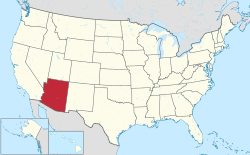 | |
| Number of elections | 29 |
|---|---|
| Voted Democratic | 9 |
| Voted Republican | 20 |
| Voted other | 0 |
| Voted for winning candidate | 23 |
| Voted for losing candidate | 6 |
Since Arizona's admission to the Union in February 1912, [1] it has participated in 28 United States presidential elections.
Contents
Since the 1950s, Arizona has been considered a stronghold state for the Republican Party, with the party carrying the state in all subsequent elections except 1996 and 2020 (and even then, Democrats won with narrow pluralities). [2] However, recent political realignment has led some to consider Arizona as a swing state, influenced by demographic changes and trends in Maricopa County and other suburban areas in the state. [2] [3]
Democrats have in less recent elections carried the state by large margins amidst favorable national environments. In the 1936 presidential election, Franklin D. Roosevelt won Arizona in a landslide, defeating the Republican Party's candidate Alf Landon by 42.92%, [4] which remains the largest margin of victory for any presidential candidate in the state's history.
The state's electoral votes came under controversy in the 2020 presidential election, when Democratic nominee Joe Biden narrowly defeated incumbent Republican Donald Trump in the state, by a margin of just 0.3%. [5] During the Electoral College vote count, 69 congressional Republicans unsuccessfully objected to the certification of electoral votes of Arizona amidst false claims of fraud. [6]
As of 2022, no Republican has won the presidency without carrying Arizona since its statehood in 1912, although Democrats have won the presidency without carrying the state on six occasions, most recently Barack Obama in 2012.